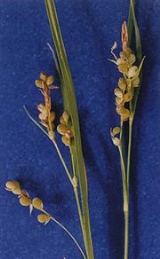
Carex aurea
Encyclopedia
Carex aurea is a species of sedge
known by the common name golden sedge. It is native to much of North America, including most of Canada and the western and central United States. It grows in wet habitat, often on soils of a basic pH
.
produces staminate
and pistillate
flowers, the latter yielding rounded fruits. The fruit is coated in a sac called a perigynium which is fleshy and green at full size and then turns bright orange just before it falls off.
Carex
Carex is a genus of plants in the family Cyperaceae, commonly known as sedges. Other members of the Cyperaceae family are also called sedges, however those of genus Carex may be called "true" sedges, and it is the most species-rich genus in the family. The study of Carex is known as...
known by the common name golden sedge. It is native to much of North America, including most of Canada and the western and central United States. It grows in wet habitat, often on soils of a basic pH
Soil pH
The soil pH is a measure of the acidity or basicity in soils. pH is defined as the negative logarithm of the activity of hydrogen ions in solution. It ranges from 0 to 14, with 7 being neutral. A pH below 7 is acidic and above 7 is basic. Soil pH is considered a master variable in soils as it...
.
Description
Carex aurea produces stems up to about 40 centimeters tall. The inflorescenceInflorescence
An inflorescence is a group or cluster of flowers arranged on a stem that is composed of a main branch or a complicated arrangement of branches. Strictly, it is the part of the shoot of seed plants where flowers are formed and which is accordingly modified...
produces staminate
Stamen
The stamen is the pollen producing reproductive organ of a flower...
and pistillate
Gynoecium
Gynoecium is most commonly used as a collective term for all carpels in a flower. A carpel is the ovule and seed producing reproductive organ in flowering plants. Carpels are derived from ovule-bearing leaves which evolved to form a closed structure containing the ovules...
flowers, the latter yielding rounded fruits. The fruit is coated in a sac called a perigynium which is fleshy and green at full size and then turns bright orange just before it falls off.

